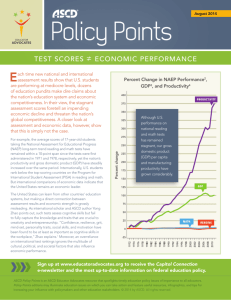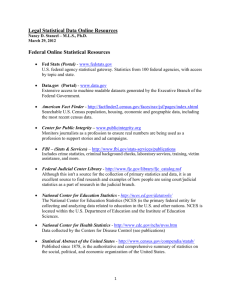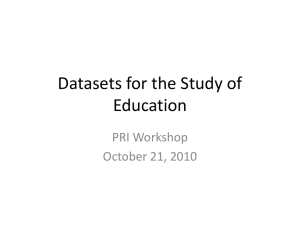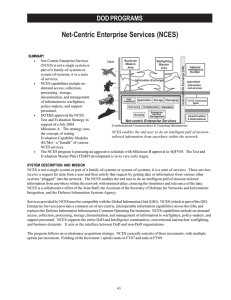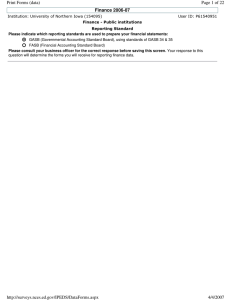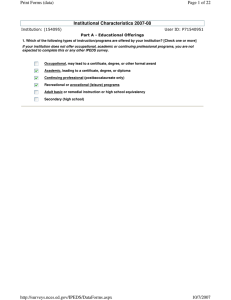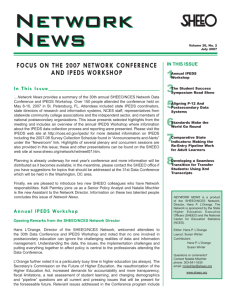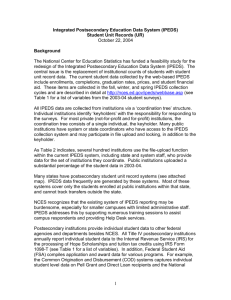State Data Resources
advertisement
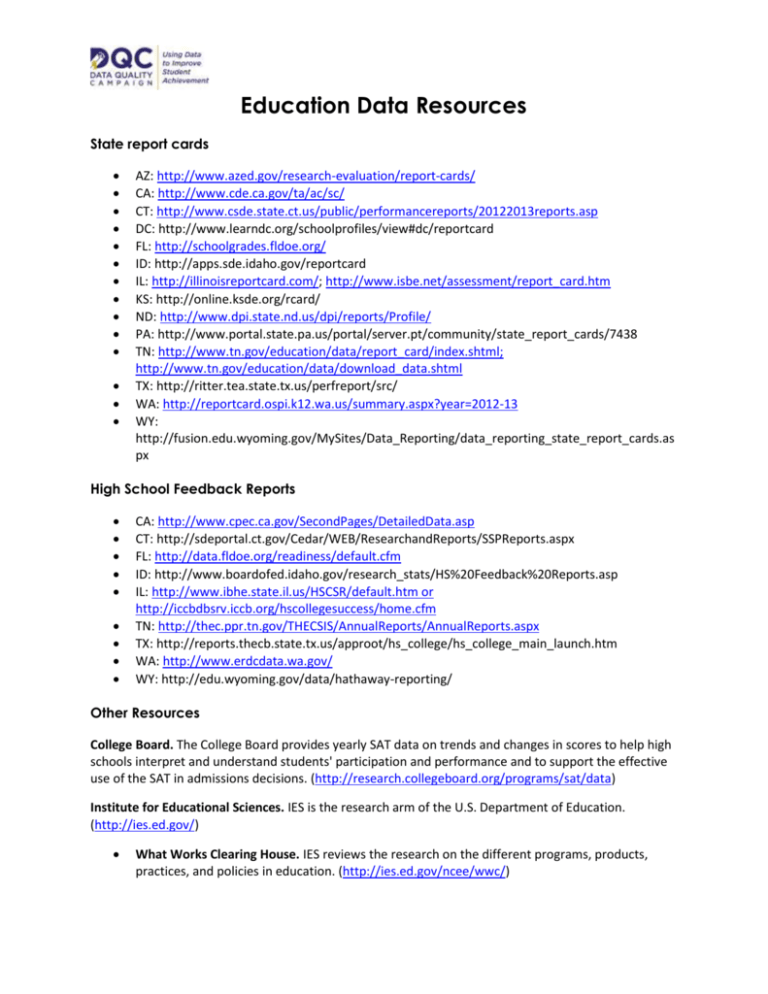
Education Data Resources State report cards AZ: http://www.azed.gov/research-evaluation/report-cards/ CA: http://www.cde.ca.gov/ta/ac/sc/ CT: http://www.csde.state.ct.us/public/performancereports/20122013reports.asp DC: http://www.learndc.org/schoolprofiles/view#dc/reportcard FL: http://schoolgrades.fldoe.org/ ID: http://apps.sde.idaho.gov/reportcard IL: http://illinoisreportcard.com/; http://www.isbe.net/assessment/report_card.htm KS: http://online.ksde.org/rcard/ ND: http://www.dpi.state.nd.us/dpi/reports/Profile/ PA: http://www.portal.state.pa.us/portal/server.pt/community/state_report_cards/7438 TN: http://www.tn.gov/education/data/report_card/index.shtml; http://www.tn.gov/education/data/download_data.shtml TX: http://ritter.tea.state.tx.us/perfreport/src/ WA: http://reportcard.ospi.k12.wa.us/summary.aspx?year=2012-13 WY: http://fusion.edu.wyoming.gov/MySites/Data_Reporting/data_reporting_state_report_cards.as px High School Feedback Reports CA: http://www.cpec.ca.gov/SecondPages/DetailedData.asp CT: http://sdeportal.ct.gov/Cedar/WEB/ResearchandReports/SSPReports.aspx FL: http://data.fldoe.org/readiness/default.cfm ID: http://www.boardofed.idaho.gov/research_stats/HS%20Feedback%20Reports.asp IL: http://www.ibhe.state.il.us/HSCSR/default.htm or http://iccbdbsrv.iccb.org/hscollegesuccess/home.cfm TN: http://thec.ppr.tn.gov/THECSIS/AnnualReports/AnnualReports.aspx TX: http://reports.thecb.state.tx.us/approot/hs_college/hs_college_main_launch.htm WA: http://www.erdcdata.wa.gov/ WY: http://edu.wyoming.gov/data/hathaway-reporting/ Other Resources College Board. The College Board provides yearly SAT data on trends and changes in scores to help high schools interpret and understand students' participation and performance and to support the effective use of the SAT in admissions decisions. (http://research.collegeboard.org/programs/sat/data) Institute for Educational Sciences. IES is the research arm of the U.S. Department of Education. (http://ies.ed.gov/) What Works Clearing House. IES reviews the research on the different programs, products, practices, and policies in education. (http://ies.ed.gov/ncee/wwc/) National Center for Education Statistics. The National Center for Education Statistics (NCES) is the primary federal entity responsible for collecting and analyzing data related to education. (http://nces.ed.gov/) Common Core of Data (CCD). The CCD annually collects fiscal and non-fiscal data about all public schools, public school districts, and state education agencies in the United States. The data are supplied by state education agency officials and include information that describes schools and school districts, including name, address, and phone number; descriptive information about students and staff, including demographics; and fiscal data, including revenues and current expenditures. (http://nces.ed.gov/ccd/) Nation’s Report Card. The Nation’s Report Card informs the public about the academic achievement of elementary and secondary students in the United States. Report cards communicate the findings of the National Assessment of Educational Progress (NAEP), a continuing and nationally representative measure of achievement in various subjects over time. Since 1969, NAEP assessments have been conducted periodically in reading, mathematics, science, writing, U.S. history, civics, geography, and other subjects. NAEP collects and reports information on student performance at the national, state, and local levels, making the assessment an integral part of our nation’s evaluation of the condition and progress of education. (http://nationsreportcard.gov/) Integrated Postsecondary Education Data System (IPEDS). IPEDS is the primary source for data on colleges, universities, and technical and vocational postsecondary institutions in the United States (http://nces.ed.gov/ipeds/) PISA International Assessment–USA. The Program for International Student Assessment (PISA) is a system of international assessments that allows countries to compare outcomes of learning as students near the end of compulsory schooling. PISA core assessments measure the performance of 15-year-old students in mathematics, science, and reading literacy every 3 years. Coordinated by the Organization for Economic Cooperation and Development (OECD), PISA was first implemented in 2000 in 32 countries. It has since grown to 65 education systems in 2012. (http://nces.ed.gov/surveys/pisa/pisa2012/index.asp) Bureau of Labor and Statistics (BLS). BLS provides information about education and training requirements for hundreds of occupations. In the education and training system, each of the occupations for which the office publishes projections data is assigned separate categories for education, work experience, and on-the-job training. Occupations can be grouped in order to create estimates of the education and training needs for the labor force as a whole and estimates of the outlook for occupations with various types of education or training needs. In addition, educational attainment data for each occupation are presented to show the level of education achieved by current workers. (http://www.bls.gov/emp/ep_education_training_system.htm) US Census Bureau–Educational Attainment. The US Census Bureau provides data on educational attainment in the United States. (https://www.census.gov/hhes/socdemo/education/) US Census Abstract–Education. The US Census Bureau’s Statistical Abstract presents data primarily concerning formal education as a whole, at various levels, and for public and private schools. Data relate to the school-age population and school enrollment, educational attainment, education personnel, and financial aspects of education. In addition, data are available for charter schools, computer usage in schools, distance education, and adult education. (https://www.census.gov/compendia/statab/cats/education.html) Federal Student Aid. The Federal Student Aid Office of the US Department of Education provides data about FAFSA submissions and completions so that high schools can track their progress and help to ensure that their students complete a FAFSA. The data reflect the number of submitted and completed FAFSAs among first-time filing applicants no older than 18 who will have received their high school diploma by the start of the school year to which they are applying for aid. The data is displayed in spreadsheets broken down by state or territory that include the school name and city of the high school. (https://studentaid.ed.gov/about/data-center/student/application-volume/fafsa-completion-highschool) GreatSchools. GreatSchools is a 501(c)(3) not-for-profit organization. Along with profiles of more than 200,000 PreK-12 schools and more than 1,000,000 parent and community ratings and reviews of schools, GreatSchools provides information, tips, activities, and tools that help parents get the best possible education for their children. (http://www.greatschools.org/) National Student Clearinghouse (NSC). NSC is a 501(c)(6) nonprofit and nongovernmental organization and a source for education verification and student educational outcomes research. More than 3,600 colleges and universities, enrolling 98% of all students in public and private U.S. institutions, participate in the Clearinghouse. Participating institutions provide access to actual enrollment and degree information on each of their students. (http://www.studentclearinghouse.org/)
